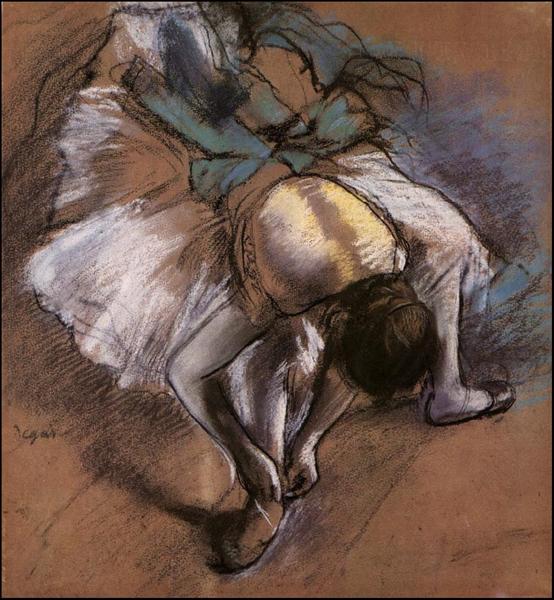描述
Edgar Degas's 1885 painting "A Dancer Adjusting Her Slipper" stands as one of the most iconic in the artist's vast corpus, known for his unique approach to ballet and dance in general. A master of movement and form, Degas captures an intimate, everyday moment in the lives of ballerinas in this painting, immortalizing the subtle tension of preparation preceding the performance. This oil on canvas encapsulates not only the intrinsic beauty of the female figure, but also the dedication and effort that underlie the elegance of the art of ballet.
The composition of the work is notable for its dynamism and rigor. Degas employs a singular perspective that suggests an almost casual point of view, as if the viewer were observing the scene from a corner of the dressing room. The figure of the dancer, at the center of the painting, is slightly twisted as she bends down to adjust the shoe on her right foot. The posture, which displays an undeniable grace and vulnerability, suggests the intimacy of the moment, while also highlighting the dexterity and attention to detail inherent in the life of a dancer. The limbs of the figure, especially the legs and feet, are treated with a meticulous approach that emphasizes the importance of these parts in the dance. The softness of the skin contrasts with the darker, richer hues of her outfit, a combination that further highlights the central figure.
Color in this work is a critical component that Degas uses masterfully. The palette is composed of predominantly warm tones, which create a welcoming atmosphere and suggest the warmth of the home environment. The soft colors of the ballerina’s white tutu contrast with the more somber background, such as the dark browns and blacks that characterize the dressing room. This color choice not only lends depth to the composition, but also brings a sense of closeness and feeling to the scene. The subtle but effective lighting caresses the dancer’s body, illuminating her face and thus drawing the viewer’s gaze to her concentrated expression.
The figure of the dancer is depicted without embellishment or idealization, a typical element of modernism that Degas embraces. His informative style reflects an interest in documenting the reality of ballet beyond the grandiosity and spectacle. Although the dancer is the focus of attention, other elements can be glimpsed in the background, such as a chair and scattered costumes, which add an air of realism to the scene, suggesting that dance is also hard work behind the beauty expressed on stage.
It is inevitable to recognize that the work encapsulates Degas' fascination with the representation of movement and the human figure, an aspect that continues to resonate in contemporary art appreciation. His ability to transcend mere portraiture and reach a psychological representation of his subjects is what gives this painting a unique and profound character. "Dancer Adjusting Her Slipper" invites the viewer into an almost voyeuristic experience, allowing them to witness an instant that often remains hidden, revealing the duality of artistic life: the struggle between the everyday and the sublime.
In the tradition of 19th-century painting, Degas' work stands as a celebration of the female figure, but also as an implicit critique of the superficiality of spectacle. Through his approach, Degas not only depicts the dancer, but raises questions about the identity, effort and dedication behind the aesthetics of dance. As a result, "Dancer Adjusting Her Slipper" becomes a masterpiece that transcends its time, offering a timeless look at the struggle between form and substance, beauty and reality.
KUADROS ©, a famous painting on your wall.
Hand-made oil painting reproductions, with the quality of professional artists and the distinctive seal of KUADROS ©.
Painting reproduction service with satisfaction guarantee. If you are not completely satisfied with the replica of your painting, we will refund 100% of your money.

